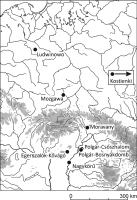. Introduction
It is stating the obvious that the dating with radiocarbon methods is one of the most important tools ordering our knowledge of the past. It allows the cultural and environmental phenomena from the past to be placed on a timescale. It also makes it possible to establish absolute chronology (Bronk Ramsey, 2001; Buck et al., 1991; Bronk Ramsey, 2009; Michczyński, 2011) and, combined with strictly archaeological data, to develop general chronological models for archaeological sites. The material which is dated are organic remains preserved in archaeological sites, including human and animal bones as well as plant remains, most often charcoal.
However, radiocarbon dates obtained from plant material are often regarded with caution, because, for a number of reasons, they do not provide reliable results. Among these reasons one should mention the following:1) lack of connection between plant material and archaeological context, 2) different fossilisation of plant remains within the same sample, 3) lack of taxonomic identification of plant remains, 4) impact of the ‘old wood’ problem.
This last factor requires a brief comment. The effect in question may stem from burning old, dead wood from a tree that had grown in a given area much earlier than it became settled. But problems may also stem from dating a charcoal sample originating from a trunk belonging to one of long-lived tree species. The trunk might have been cut and used in the cultural context that we want to date (Schiffer, 1986, 1996), but the ‘old wood’ effect results in the dates being inevitably older than the context from which the sample was taken. As a result, the chronology of the dated site or prehistoric phenomenon will be to a smaller or larger extent incorrect.
This danger becomes fully apparent when we compare the dates obtained from charcoal with those obtained from other organic substances, in which the discussed effect does not appear, and which originate from the same context. This was very convincingly demonstrated in a classic study by W. Stöckli (2002: fig. 13), where three Linear Band Pottery culture (Linearbandkeramik – LBK) sites were compared. The difference between charcoal and bone dates is very clear, with some of the charcoal dates being earlier than the remaining ones. Some of them even precede the earliest possible date for the appearance of LBK in the Rhine basin established on the basis of our knowledge of Neolithic prehistory. In other words, these dates are completely unreliable. Obviously enough, such situations lead to the preference (wherever possible) of dates obtained from other materials, which in the Neolithic contexts means primarily from bone.
The problem of the ‘old wood’ has been raised many times in archaeological literature (Schiffer, 1986; Nowaczyk, 1990; Whittle, 1990; Lityńska-Zając, 1994; Housley, 1999; Dobrzańska et al., 2004; Walanus and Goslar, 2009: 9–10, fig. 1; Moskal-del Hoyo and Kozłowski, 2009; Brock et al., 2010; Michczyński, 2011: 40–41). However, in our opinion the most significant part of the problem with the dating of plant material results from the fact that they are still very rarely identified taxonomically (Damblon and Haesaerts, 2002; Moskal-del Hoyo and Kozłowski, 2009).
An example of dangers associated with the lack of such identification may be the Upper Palaeolithic site Egerszalók-Kővágó, in northern Hungary (Kozłowski et al., 2009). In the same layer, two charcoals were found, which occurred next to each other. They had been analysed taxonomically. One of them turned out to be Picea abies vel Larix decidua (spruce or larch), and this fits well to Pleistocene environment. The second charcoal turned out to be oak, which is rather unusual for Glacial environment. For this reason, charcoals were sent to dating separately. The age of Picea/Larix is Upper Palaeolithic (ca. 28,000 BP), but the age of oak is more than 20,000 years younger. If both charcoals had been dated as a single sample, they would have given the “averaged” date, located somewhere between the above two results. That would have been simply a false outcome.
Similar examples provided the Upper Palaeolithic site of Kostienki 12 (near Voronezh in western Russia), where among the charcoals of coniferous wood, like Picea, and Pinus (pine), charcoals of broad-leaved taxa were found, such as Quercus (oak), and Fraxinus (ash tree). Both groups of trees were dated separately: conifers correlated well with the Pleniglacial sequence of the site, while broad-leaved trees were of the Holocene chronology. These results show important post-depositional disturbances and highlighted the preference for dating coniferous wood when working with the Upper Palaeolithic charcoals (Damblon and Haesaerts, 2002).
Certainly, charcoals and seeds or fruits are an integral component of archaeological data set that is as important for reconstruction of past reality as e.g. ceramics or lithics. In other words, besides the absolute chronology of archaeological features and artefacts, radiocarbon dating of identified plant remains might significantly contribute to the history of local vegetation and food production systems of a given prehistoric or historic community.
. Case studies
The benefits and weaknesses of dating of archaeobotanical samples will be analysed based on some case studies from Hungarian (Nagykörű, Polgár-Bosnyákdomb, and Polgár-Csőszhalom), Slovak (Moravany), and Polish (Ludwinowo and Mozgawa) archaeological sites, referring to Early and Middle Neolithic periods (Fig. 1).These case studies have been performed by authors of the presentation within several research projects.
Nagykörű
Nagykörű, located in the central part of the Great Hungarian Plain, is the site of the Körös culture (Raczky et al., 2010). This unit is archaeological reflection of the first wave of Neolithic migration to the north-eastern part of the Carpathian Basin. It is generally dated to the first half of the sixth millennium cal BC.
The radiocarbon dating of the site (Fig. 2) was based on four undetermined charcoal fragments (VERA-3052, VERA-3474, VERA-3476, VERA-3540 – Raczky et al., 2010: 164; Raczky and Anders pers. comm.). According to cited authors these dates indicate the occupation of the site between 5990 and 5620 cal BC. However, during next studies taxonomical analyses of all charcoals from the site brought to selection of specimens like: the most external rings, branch woods, twigs, and young shoots. Three AMS dates (Fig. 2) were made: 1) on young shoot of Quercus sp. (Poz-26325), 2) on branchwood of Ulmus sp. (elm; Poz-26327), and 3) on branchwood of Prunus sp. (plum; Poz-26328) (Moskal-del Hoyo, 2010).They narrowed chronology of the site to at least ca. 5900–5700 cal BC, if we throw out the most external parts of the calibration ranges, of the low probability. Certainly, the date of ca. 5900 cal BC is only one of several possible interpretations. Due to properties of calibration intervals of two older datings and the scope of the start boundary interval in “phase” modelling (Fig. 2: 2) it is possible to rejuvenate this date even up to approx. 100 years. As regards the end of the settlement, it seems logical that younger dates obtained from undetermined charcoals should be accepted. The ‘old wood’ problem strongly suggests that in a group of datings which define a specific period of time, the youngest ones should be considered as related to human activity (such as felling a tree, from which the sample originates). Of course, the date of 5620 cal BC is a “safe” one because is based on the latest point of time within the calibration range of the youngest date VERA-3052. However, the disappearance of the Körös culture settlement at Nagykörű could be moved up to approx. 5700 cal BC or to some point between 5700 and 5620 cal BC as well.
Fig. 2
Nagykörű. 1: radiocarbon dating; 2: “phase” modelling of dates obtained on “short-lived” wood (all calibrations and modelling were performed by OxCal 4.2.4 – Bronk Ramsey, 2009; Reimer at al., 2013); 3: twig of Quercus sp. (left and right: transversal section). Micrographs by M. Moskal-del Hoyo.
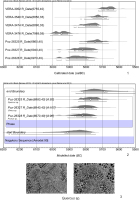
Therefore, the start and end of the settlement should be set at approx. 5900/5800 and 5700/5600 cal BC, respectively. Consequently, the thesis about the existence of the settlement already in the 60th century BC, which is in contradiction with current views on the spread of the Körös culture, should be rejected. In other words, we consider the date VERA-3476 as an effect of ‘old wood’.
The dating of ca. 5900/5800 cal BC is still quite early for the beginnings of the Körös culture in the middle Tisza region, i.e. earlier than might have been expected on the basis of previous knowledge (Whittle et al., 2002, 2005; Domboróczki et al., 2010). Thus, due to the dating of young shoot and branchwood a support of the early chronology of the Neolithic appearance in the area was obtained. It seems probable that this chronology is not the (false) result of the ‘old wood’ problem.
Moravany
In the village of Moravany, in the Eastern Slovak Lowland, there is a settlement of the early and partly the middle phase of the Eastern Linear Pottery culture (Alföldi Vonaldíszes Kerámia – AVK) (Kozłowski et al., 2015). This culture covers in practice the whole basin of the Tisza river. In the north-eastern and northern parts of this territory there are no sites of the Körös culture; therefore the AVK is the first Neolithic culture there.
Twenty radiocarbon dates were obtained from undetermined taxonomically charcoals (Fig. 3: 1) gathered in anthropogenic features of that culture at the settlement of Moravany (Nowak, 2015). These dates are characterized by a great dispersion, from the Last Glacial Maximum until the beginning of the Eneolithic period. Obviously, this is a time span far beyond the span of the entire AVK (ca. 5600–5100 cal BC). What are the reasons for this situation? To solve the problem, the last series of datings was performed on samples identified taxonomically. It turned out that next to the taxa typical of the early Holocene environment, plants quite unusual for this period were also found, including Picea sp.vel Larix sp., Fagus sylvatica (beech), and Carpinus betulus (hornbeam). They were also sent to the AMS dating. As could be expected, a very early date was obtained from Picea or Larix (Poz-22307), while young, late Holocene dates were obtained from Fagus sylvatica (Poz-22308) and Carpinus betulus (Poz-22309) (Fig. 4).
Fig. 3
Moravany. 1: radiocarbon dating of all taxonomically undetermined charcoals of Holocene age; 2: radiocarbon dating (“phase” modelling) of all charcoals determined as Quercus sp., found in anthropogenic features of the Neolithic age; 3: Quercus sp. (left: transversal section and right: tangential section). Micrographs by M. Moskal-del Hoyo.
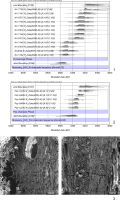
Fig. 4
Moravany. 1–3: Picea sp. vel Larix sp. (1. transversal section, 2. tangential section, 3. radial section); 4: Fagus sylvatica (transversal section); 5–6: Carpinus betulus (5. transversal section, 6. radial section), and radiocarbon dating of these charcoals. Micrographs by M. Moskal-del Hoyo.
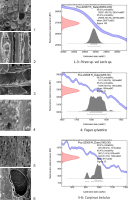
In contrast, dates obtained from the Quercus charcoals point at the second half of the sixth millennium cal BC (Fig. 3: 2), broadly in line with archaeological material. These oak charcoals were preserved as very small fragments and thus it was not possible to detect if they come from external rings, branchwoods, twigs, or young shoots. However, it is likely that in this case the ‘old wood’ problem was avoided because these fragments most probably represented fuelwood collected in form of branches in the vicinity of the site as they were found dispersed within the fillings of the Neolithic pits together with the remains of other woody taxa (Lityńska-Zając et al., 2008; Moskal-del Hoyo et al., 2015). Nevertheless, the comparison of these “oak” dates (Fig. 3: 2) with dates of undetermined charcoals of Holocene age (Fig. 3: 1) strongly suggests that the earliest of the latter dates should be rejected.
By way of a kind of interpolation, we presume that all datings older and younger than the Early Neolithic should be associated with plants untypical for the mid-Holocene environment. Their presence in anthropogenic features demonstrates that cultural and natural post-depositional processes, which influenced content of these features, were active in the area of the site. Older charcoals, could get there, firstly, during digging of pits, as a result of cutting lenticular concentration of the Late Glacial charcoals. The occurrence of such concentrations within the site was observed in geomorphological trenches. Besides, this idea is confirmed by the fact that charcoals of the presumable Late Glacial chronology mostly come from samples collected in the border zone of the lower sections of archaeological features and natural layers. Such samples usually contain some amount of yellow, clayey sediment. Secondly, older charcoals could be deposited there during the usage of the features, and – thirdly – after leaving the settlement. In turn, only the last option can explain the delivery of the younger charcoals.
Consequently, it was considered reasonable to eliminate all the charcoals of trees that provided above-mentioned early and late dates, from the overall reconstruction of environmental context of the Early Neolithic settlement at Moravany (Lityńska-Zając et al., 2008; Moskal-del Hoyo et al., 2015).
The series of dates obtained at Moravany, even after the above elimination procedures, is the largest one in the entire eastern Slovakia, regarding the local Early Neolithic. These dates, which by interpolation can be hypothetically considered as made exclusively on oak samples, give a compact and relatively certain chronology of ca. 5500–5150 cal BC (Kaczanowska et al., 2015: 236; Nowak, 2015) and, therefore, allow to generate the chronology of the early and middle AVK in the Eastern Slovak Lowland which is much more likely than before. Until now, that chronology was based only on one radiocarbon date (Šiška, 1989: 125) and the relative chronology of pottery, which relied heavily on analogies and comparisons with eastern Linear materials from Hungary. The latter system did not always give good results, because of possible local specifics of cultural development. Some problems associated with the relationship between radiocarbon dating and characteristics of pottery found at Moravany (absolute dating suggests rather multi-phase occupation, as opposed to ceramic typology – comp. Šiška, 1989; Vizdal, 1997; Vizdal et al., 2015; Nowak, 2015) do not decrease significantly the importance of developed chronology. Contrary, this chronology suggests to re-examine the value and relevance of the current indicators of ceramic relative chronology. Such situation is often met, when we manage to get a larger number of radiocarbon dates at a site of either the Western (e.g. Dębiec, 2014) or the Eastern (e.g. Kalicz and Kós, 2014) Linear Pottery culture. One way or another, the developed model of absolute chronology of the AVK in the Eastern Slovak Lowland allows to more realistically assess the value of existing chronological schemes and to put forward some modifications to them (Kaczanowska et al., 2015; Nowak, 2015).
Polgár-Csőszhalom and Polgár-Bosnyákdomb
We deal with a slightly similar situations in the case of two Late Neolithic sites situated in the Upper Tisza river basin: Polgár-Csőszhalom (Raczky et al., 2002, Raczky and Anders, 2008) and Polgár-Bosnyákdomb (Raczky and Anders, 2009a, 2016). It should be emphasized that the first one consists actually of two clearly separate parts: a small tell settlement and a large horizontal settlement. As can be judged on the basis of several dozen dates, made primarily on bones, these two settlements of Polgár-Csőszhalom were inhabited in the first half of the 5th millennium cal BC, but Polgár-Bosnyákdomb only at the end of this period (Raczky and Anders, 2009b, 2010, 2016).
The anthracological analysis from these sites were conducted in order to reconstruct woodland vegetation near Polgár settlements during the Middle Neolithic occupation (Moskal-del Hoyo, 2013; Moskal-del Hoyo and Lityńska-Zając, 2016). Taxonomical analyses revealed the presence of single charcoal fragments belonging to Carpinus betulus, which is an untypical tree for the middle Holocene. One charcoal from the horizontal settlement of Polgár-Csőszhalom was dated because its presence in Neolithic layers could suggest its early appearance in local forests, meaning the early spread of this late-arriving tree in Central Europe (Magyari, 2002). However, its dating is young; it corresponds to the turn of the Roman and Migration Periods (Fig. 5: 1). But there are also “good” dates among taxonomically labelled materials. These include, among others, the date of twigs of Cornus sp. (dogwood or Cornelian cherry), i.e. of a relatively short-lived plant (Fig. 5: 2). Charcoal of Cornus was selected because it is a typical component of wood charcoal assemblages in these sites and other contemporaneous settlements from the Great Hungarian Plain. At both sites it ranks third, just behind oak and elm (Moskal-del Hoyo, 2013), but is more suitable to be radiocarbon dated than oak and elm, which are long-living trees.
Fig. 5
Polgár-Csőszhalom and Polgár-Bosnyákdomb. 1: Carpinus sp. from Polgár-Csőszhalom (left: transversal section and right: two micrographs of radial section); 2: Cornus sp. from Polgár-Bosnyákdomb (left: transversal section and right: radial section). Micrographs by M. Moskal-del Hoyo; 3: radiocarbon dating from the ditch of Polgár-Bosnyákdomb in relation to the depth; 4: awn of Stipa sp. from the ditch at Polgár-Bosnyákdomb. Photo by M. Lityńska-Zając.
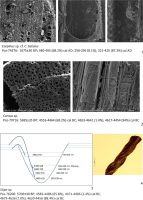
Worthy of mention is the date obtained from a fragment of awns of Stipa sp. (feather grass) from Polgár-Bosnyákdomb (Fig. 5: 3–4). This is the date of the same age as dates made on bones which were found in the same stratigraphic context, that is in the bottom layers of a ditch (Fig. 5: 3) (Raczky and Anders, 2016). It should be therefore emphasized that the date of the short-living plant (Stipa belongs to hemicryptophytes, which above-ground parts die every winter, i.e. these parts are de facto annual ones) is as good as bone dates are. In theory, as in the case of other annual plants, e.g. cereals, we could get a date with a precision up to one year. However, so accurate measurement of preserved 14C is beyond the technical possibilities of radiocarbon labs.
Ludwinowo
Ludwinowo is situated in north-central Poland, in the territory of Kuyavia. It is one of many local sites of the LBK, which is the first Neolithic unit in Central Europe. The settlement concentration of the LBK in Kuyavia is exceptional in lowland territories of Central Europe due to high number of recorded sites (ca. 300 – Pyzel, 2010: 141). This concentration shows how intensive was utilisation of small enclaves with fertile soils by the first Central European farmers, even if located in areas remote from initial and secondary centres of the „Linear” migrations, which were situated in the middle Danube basin and in the upland belt of the East-Central Europe. It is worth mentioning that the lowland LBK do not differ from its southern parts, in terms of both material culture and settlement or economic patterns.
At Ludwinowo three 14C dates were obtained from taxonomically identified plant remains, which occurred in two features situated in the south-western part of the site (Mueller-Bieniek et al., 2015) (Fig. 6). One date derives from Triticum monococcum (einkorn; Poz-72392) chaff (Fig. 6: 2) and one from Cerealia grain (Poz-77284). They both fit very well into the chronological characteristics of the archaeological materials.
Fig. 6
Ludwinowo. 1: radiocarbon dating; 2: wheat chaff fragments from Ludwinowo; 3. Chenopodium sp. from Ludwinowo. Photos by A. Mueller-Bieniek and M. Szewczyk.
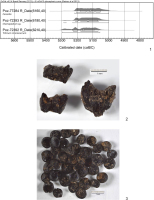
Perhaps the most interesting is the third date, made on seeds of Chenopodium sp. (goosefoot; Poz-72393) (Fig. 6: 3). At the site of Ludwinowo a large amount of goose-foot seeds was discovered, both in the charred and uncharred form. The latter ones are probably much younger than Neolithic or even recent, because in archaeobotany they think that uncharred remains, preserved in archaeological layers, located in the so-called dry sites, are an admixture of younger or even current age, not associated with the archaeological context. For such sites, permanently located above the groundwater level, there are no conditions favourable to maintenance of unburned specimens (Bieniek, 1998; Lityńska-Zając and Wasylikowa, 2005: 41–51). They could get to the sediment from the “seed bank”, residual in the soil, or from the immediate surroundings, during picking up, drying or floating samples in field investigations. In case of Ludwinowo, the question had emerged, what was the age of the charred remains? The dating demonstrated the Neolithic age of charred Chenopodium seeds, identical with age of wheat chaff from the same sample. Remains of Chenopodium turned out to be not only younger admixture.
These three dates from annual plants are mutually compatible, i.e. point to ca. 5300/5200–5100/5000 cal BC. Two of them derive from a pit and one from a posthole. Because in the latter feature there are no archaeological artefacts, such dating is a decisive argument for connection of the post-hole with the LBK, and – consequently – for recognition of the whole arrangement of post-holes and pits in this section of the site as remain of yet another house of local community of this culture.
Mozgawa
The site at Mozgawa, in southern Poland, belongs to the Funnel Beaker culture (Trichterbecherkultur – TRB). This is quite big settlement that covers almost 35 hectares. The Funnel Beaker culture is considered as an archaeological reflection of the so-called second stage of neolithisation. In a nutshell, that process can be described as covering the whole landscape by Neolithic settlement, contrary to situation in the 6th and 5th millennia BC, when Neolithic tended to concentrate on areas with the best ecological conditions for agriculture.
So far, eleven dates were obtained from plant material found in features of the TRB at Mozgawa. One of them refers to the early Bronze Age and corroborates the operating of post-depositional processes, later than Neolithic. Other dates (Fig. 7) are congruent to each other and indicate settling of the village around 3600–3400 cal BC, and possibly, perhaps with a lesser intensity, in the later part of the fourth millennium cal BC. This perfectly corresponds to chronological characteristics of archaeological findings. In these findings, mainly in pottery, characteristics of the so-called classical phase of the south-eastern group of the TRB, placed around mid-fourth millennium cal BC, can be recorded (Włodarczak, 2006; Nowak, 2009). On the other hand, pottery with elements of the so-called Beaker-Baden assemblages, dated to the turn of the 4th and 3rd millennia BC (Zastawny, 2008, 2015), were also noticed. It is also worth noting that Beaker-Baden assemblages were discovered first and foremost in eastern part of the Western Lesser Poland less uplands (Kruk and Milisauskas, 1999: 171–215), i.e. in the region where the settlement of Mozgawa is situated.
Fig. 7
Mozgawa. 1: radiocarbon dating (“phase” modelling); 2: branch of Pinus sylvestris (left: transversal section and right: radial section). Micrographs by M. Moskal-del Hoyo.
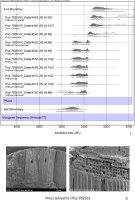
Among these ten dates, nine were made on annual plants, of which seven on wheat grains. One date comes from Lens culinaris (lentil), which was also cultivated by communities of the TRB (Lityńska-Zając and Wasylikowa, 2005; Lityńska-Zając, 2013). Certainly, the date from Bromus sp. (brome), which fits well into other dates, is worth emphasizing. This demonstrates that dating other annual plants than cereals can be also useful for Neolithic phenomena.
One date was obtained from pine charcoal (Fig. 7: 2). It also correlates very well with other dates. This is not surprising, as the morphologically identified branchwood was purposefully handed for dating. As it turns out, once again, the date of charcoal not necessarily has to be too young, if made on suitably selected samples.
. Discussion
The case studies presented above illustrate a number of benefits flowing from the proper selection of plant material for radiocarbon dating.
The dating of annual or biannual plants makes it possible to obtain dates that usually overlap and produce a narrow time range, which correlates well with the chronology established on the basis of other, ‘reliable’ materials, i.e. first of all bones. Dates from short-lived plants and from bones mutually confirm each other, as illustrated by the dating of the Stipa sp. in Polgár-Bosnyákdomb. Furthermore, these dates agree with what is suggested by the chronological analysis of archaeological materials, as exemplified by Ludwinowo and Mozgawa. When archaeological material is lacking in a feature, they can provide a reliable clue for the cultural identification of such feature, or even entire complex of features (vide Ludwinowo).
Of course, apart from information of a strictly chronological nature, dates of that kind obtained from domesticated plants reveal what species were cultivated by a given community. On the other hand, dates from shortlived wild plants or those that were not cultivated in the Neolithic can convincingly demonstrate their attribution to the Neolithic context, as for example with Stipa in Polgár-Bosnyákdomb or Chenopodium in Ludwinowo. Such an attribution is not automatically certain, and the dates allow us to rule out the possibility that these plants were younger admixtures. In this way, our understanding of the environmental context for human settlement can become more complete, and the same applies to our knowledge about the potential exploitation of these plants or about human-environment relationships in the past.
The dating of plant remains representing species uncommon for the environment in which given human groups developed (here: Early and Middle Neolithic communities) and which were identified by archaeobotanical analysis often results in the dates which diverge greatly from what might be expected based on the archaeological context. Apart from providing confirmation for our assessment of what is and what is not typical for the flora of a given territory and time, such dating (reliable as it indeed is) allows us to demonstrate the operation of post-depositional processes which, be they cultural or natural, transform the original contents of anthropogenic features, introducing to them older or younger artefacts and natural substances (Schiffer, 1996). The operation of such processes should be taken into account in the case of plant remains, too. The discussed dates are one more, and very convincing, proof that anthropological features discovered on archaeological sites are not closed assemblages (also with respect to plant remains), the fact still quite often ignored by archaeologists, archaeobotanists, and scholars from other disciplines directly or indirectly interested in the human past.
The dates obtained from plants ‘atypical’ of the Neolithic, and which considerably diverge from the expected ranges, should be eliminated from the analysed cultural context. The dates that remain offer a reliable chronology, consistent with hitherto findings concerning the chronological position of particular archaeological materials. The best example of such a situation is the Moravany site.
On the other hand, the dates of the discussed type enrich our knowledge about the environmental conditions in other periods, as demonstrated in Moravany and the two sites from the Polgár quoted above.
The dating of young shoots, branchwood, and external rings brings similar results, i.e. allows the chronology of a site to be narrowed down. As mentioned, in the case of Nagykörű this meant that the beginnings of the Neolithic (Körös culture) occupation on the middle Tisa needed to be dated approximately 100/200 years later. On the other hand, this initial date is much more reliable now, and corresponds well with the existing models of the Körös culture territorial development (Whittle et al., 2002, 2005; Domboróczki, 2010; Domboróczki and Raczky, 2010; Domboróczki et al., 2010).
The chronology of ‘short-lived’ wood correlates with radiocarbon chronology based on materials other than wood, where such materials are available (vide Nagykörű, Polgár-Bosnyákdomb, and Mozgawa). This allows for a conclusion that the dates (or even a single date!) obtained from ‘short-lived’ wood should be generally considered reliable, even if no other grounds for establishing the chronology of a given site are available.
. Conclusions
The examples presented above, along with their discussion, clearly indicate that a number of factors need to be considered when selecting samples for radiocarbon dating. First of all, one should bear in mind that “radiocarbon laboratory dates the sample we submit, not the feature we want to date with that sample” (Lityńska-Zając and Wasylikowa, 2005: 59). Therefore, the connection of the analysed sample with a feature and layer should be each time determined, and possible contaminations eliminated.
It is best to date single, “large” specimens, known as plant macroremains, such as fruits, seeds, buds, leaves, and other vegetative parts (Wasylikowa, 1986), including also those of wild plants. For obvious reasons, the dates obtained from the remains of annual or biannual plants, whose lifespan is limited to one or two vegetative seasons, are closest to reality. They give a compact period of time, usually narrower than the chronology based on charred wood fragments, and consistent with chronological suggestions based on pottery, chipped lithics, stone artefacts, etc.
The situation is different in the case of long-lived organisms such as trees. As regards charcoal, fragments determined as twigs, branches, and external rings should mainly be taken into account, while those belonging to long-lived elements of trees should be avoided. Then it turns out that such dating does not differ in terms of precision from the dating obtained from other materials.
These dates, as well as the above-mentioned dates of fruits and seeds allow for the rejection of some of the dates made on undetermined charcoals, usually the earliest ones in a given situation.
The presence of unexpected taxa from the perspective of the history of local flora and cultivation practices may indicate some taphonomic and stratigraphic problems. These taxa illustrate the significance of the detailed botanical identification, since plant materials of the Neolithic age include only a limited number of cultivated species and typically do not contain remains of late arrived and late used plants. In other words, there is a big risk of getting dates later than the Neolithic. But such dates are also valuable. They are important for the history of local vegetation, and demonstrate the operation of a variety of cultural and natural post-depositional processes within a given archaeological site.
To finally recapitulate, our contribution emphasises the necessity of taxonomical identification of plant remains prior to radiocarbon dating as a measure for choosing the most relevant materials. The most appropriate specimens should be selected using the knowledge about plants typical for each chronological period in a given region, including wild and cultivated ones. If we want to properly date a feature or a site, and not only the sample, then we have to choose what is the most typical for specified time and place.
